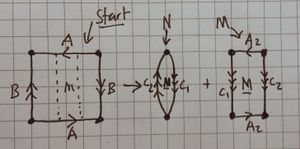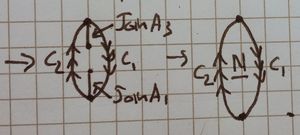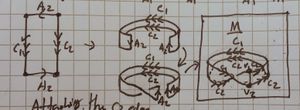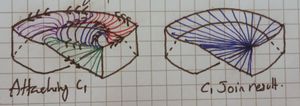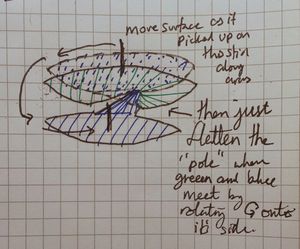Exercises:Mond - Topology - 2/Section B/Question 6
Section B
Question 6
The picture on the right shows that RP2 contains a Mobius strip, M. Use the diagram, taking into account the glueings, to describe the complement of M in RP2. You mare allowed to cut it, provided you then glue it back together.Complete the following sentence in as clear a way as possible:
- "RP2 is obtained from a Mobius strip by ....."
Solution
| Step | Picture | Comment |
|---|---|---|
| 1 Dividing up the square |
We first take the square and cut it up, creating new edges for gluing, C1 and C2 (see the picture at the top of this question) |
To yield two "chunks", N and M. |
| 2 Making the Mobius band |
We start with M on the left. | Pretty self explanatory and routine, my pictures turned out really well, I am a little bit proud. |
| 3 Joining the C2 edges |
The picture here shows only "half" of the N surface, it is the result of stitching along the C2 boundary.]] | |
| 4 Joining the C1 edge |
We start with the green and just pull the C1 edge along and start stitching. Then we pull that around - and stitch along the way - resulting in purple. Then we pull that almost all the way around yielding red.
As before, we then pull the free-edge in, until there's a tiny gap and the remaining join results in almost parallel curves. The right hand image shows the result, which is significantly simpler than the C2 case | |
| 5 N surface |
This shows what becomes of N when it is stitched to M along the C1 and C2 boundaries shown earlier, without M drawn. | |
| 6 Final topological immersion |
A diagram showing them together is very cluttered and hard to see (it either looks a mess, or a cylinder with a twist in the side), so I will show it like this.
We see (a topological immersion) of RP2 in R3 is simply the union of a Möbius strip together with a "solid 8" shape, oo but joined. Take the left "disk" in this formation and lift it, then rotate it over the first disk in the formation. In this picture we imagine sticking a "stick" into the centre of the blue disk, on which the blue "wheel" can rotate freely, we move that stick along the arrows shown, the result is blue-and-green joined along a vertical pole. If you rotate that "pole" anticlockwise, so onto it's side, parallel to the x-axis on the paper it is drawn, you then have a oo shape where the os are joined (that "pole" being the join between the two) | |
- Media:FullPageForRp2TopImmersion.JPG shows a picture of the entire page containing most of my drawings, these may help with marking.
Notes
References
